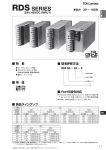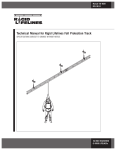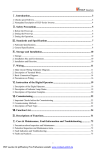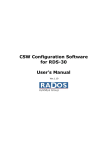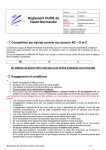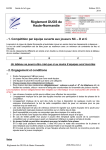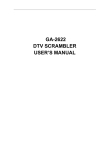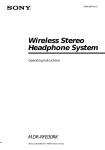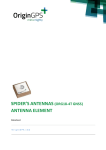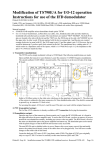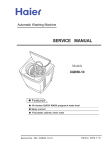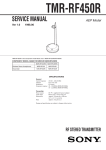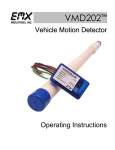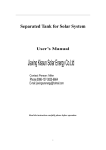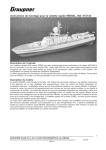Download User`s Manual
Transcript
OMXIE-SMTmax CORPORATION Computer omputerized ized Reflow system User’s Manual Tel: (951) 543-4543 Fax: (951) 582-9422 Add: 125 Business Center Drive, Unit G, Corona, CA 92880 Email address: [email protected] Disclaimer SMTmax/Omxie Corp. shall not be liable in contact, tort, or otherwise, for any loss or damage suffered by the purchaser(s) whatsoever or whosoever arising out of, or in connection with, the use of this equipment, other then, at the option of SMTmax/Omxie Corp., to refund the purchaser money in respect of the equipment if purchaser(s) returns equipment in unused, resalable condition, after having obtained written approval to do so from SMTmax/Omxie Corp. Any use of the oven not explicitly described in this manual is strongly advised against and will void purchaser’s warranty. Equipment is not suitable for heating food, liquids or tissue. Equipment must not be used in the vicinity of children, animals or unqualified people. CONTENT 1. Equipment general knowledge 2. Equipment setting 3. Equipment operating instruction 4. Lead-free techniques recommend 5. Specification and Heat Zone mount 6. Equipment Maintenance 1. Equipment general knowledge 1.1 Heating principles: 1.1.1 Heater modality: modality The two types of heating elements are general heating-rays (convection) and infrared-rays. The main structure of the heater is loading the 1 nickel-chrome alloy heater line into metal pipe and loading into silicate, makes the heat transfer out of the metal pipe into the air. Another note, the infrared ray structure is loading the nickel-chrome alloy heater line into ceramic pipe then loading into silicate and smearing special chemical on the surface, it brings the infrared ray a wavelength that is 4.5um. 1.1.2 Heat up principium: principium: The hot air source comes through the ceramic heater, that heats onto the PCB surface and to various SMC, SMD and Solder Paste, Please assure the temperature distribution is counterpoise into equipment and working area. Also, a few infrared rays have a wavelength of 4.5um with air molecule \PCB\SMC engender part quantity of heat. The infrared ray that wavelength is 4.5um is best wavelength for heating purpose. 1.1.3 Characteristic of heat transfer transfer 1.1.3.1 The hot air comes comes through IR heater: ·The IR heater shadows the SMD grotesque in shape at first hand; · It prevents partial place heat excess; · It keeps diversified SMC\SMD\PCB heating temperature distributing equilibrium; ·It keeps SMC\SMD\PCB lying in different places heating temperature distributing equilibrium; · It can also solder PCB board that are made from multifarious material. 1.1.3.2 A few infraredinfrared-rays rays ·IR heater will directly heat onto the PCB board, reduces air flux; ·It reduces oxidation of the solder; ·It makes the equipment overall power sufficient; ·It makes the temperature rise at a swiftly rate; · IR ray keep the environment clean, it can decompose 2 colophony in the solder. 1.1.4 Heat structure 1.1.4.1 Structure of Heat zone Equipment type AE-R330A AE-RF430-CF AE-RF530-C AE-RF530-CF AE-RF630-C AE-RF630-CF AE-RF830-CF AE-RF630-CEF AE-RF830-CEF Heat zone quantity Top heater quantity 5 4 5 5 6 6 8 6 8 5 group 3 group 3 group 3 group 4 group 4 group 4 group 3 group 4 group lower heater quantity 0 group 1 group 2 group 2 group 2 group 2 group 4 group 3 group 4 group Startup power Work power 6kw 6kw 7kw 7kw 8kw 8kw 10kw 8kw 10kw 2.5kw 2.5kw 2.5kw 2.5kw 3kw 3kw 3kw 2.5kw 3kw 1 . 1 . 4 . 2 Temperature test dot Every last heat zone peg has a standard thermocouple test dot; this dot is a static-state test dot which test temperature of the heat zone. (This dot has been tested before shipment, currently cannot shift placement if it has not been approved by the manufacture.) 1 . 1 . 4 . 3 Temperature controller Every last heating zone is controlled by a Temperature controller which is buildup by hardware and software. Temperature controller test static-state temperature dot, it has PID operation function and SSR drive function. 2.2 The Temperature Profile AE serials equipment is used of thawing the Soldering Paste 3 and soldering PCB and SMC\SMD component. Heating through the PCB surface and SMC\SMD, Obtain the Temperature Profile as been prescribed. Our Suggested Temperature Profile by IPC as follows. Suggested Temperature Profile Temp. (℃) 250 210℃ ~230℃ 200 A-Line 150 120℃ ~150℃ 100 C-Line B-Line 50 0 30 60 90 120 ti Line A:Is used generally for Soldering Paste. The temperature of A PCB rise to 120-150℃ from room temperature in 60S, and the heat rate under 3℃/s. The heat temperature of the PCB keeps about 150℃ in 60S~150S. Then the Soldering Paste melting point occurred, PCB board temperature becomes balance. 4 PCB soldering: The temperature of PCB keeping 210℃-230℃ in 30S. Here Soldering Paste has been reflow sufficient. Line B: It can be used for soldering micro-miniature distance SMD for instance QFP and BGA.Through control temperature rise rate at Preheating zone, delay Flux intenerated time in Soldering Paste, It controls the micro stannum-ball heat flowing all together and forming stannum-ball. Line C: It is used for SMT Glue water solidifies. The temperature of PCB keep basic constant temperature time about 150℃ in 90S~300S. In order to get high output at high automatic SMT line, U must set the Temperature Profile carefully before starting your application .And supervise must settled down to study in earnest for the examination. 2.4 2.4 Heat zone function described described 2.4 2.4.1 Preheating Preheating zone Also be named as temperature rising swift zone, is used for preheating the PCB and vaporizing impregnate. 2.4 2.4.2 Impetuous Zone (heat (heat preservation Zone) The time must be set correctly for your PCB board through this zone, Must be a constant temperature environment ,PCB and Soldering 5 Paste occur physically and chemically transformation, prepare for soldering PCB and Soldering Paste reflowing. 2.4 2.4.3 Reflow zone The reflow heating solder zone, hot air or infrared heater offer abundant quantity of heat. The temperature in the reflow zone for the top heater would be higher than bottom in order to engender reflow on PCB top surface. 2.5 2.5 Heat zone setting 2.5.1 Set initialization of heat zone and conveyance rate 2.5.2 Preheating time (warm up) is almost 20Min-30 Min for cold oven. 2.5.3 PCB is moved through oven as temperature has arrived a balance,in this status Soldering Paste arrive reflow critical temperature. 2.5.4 If reflow has not occurred, it should reduce transport rate of stainless steel belt 5 to 10%. Another method is to increase the setting temperature when transport rate is invariableness. Commonly it should raise 5℃ at a time, you should pay attention to the temperature setting of oven, and it must not exceed PCB support. 2.5.5 Temperature Profile may be adjusted basing on complexity of PCB. 6 3. Equipment setting 3.1 Equipment setting surroundings 3.1.1 Please run equipment in clean surroundings; 3.1.2 Please avoid using equipment in high temperature or dank environments. 3.1.3 Don’t set equipment by fountain of electromagnetism disturbing. 3.1.4 Don’t make the reflow oven import and export toward fans or windows which is used to ventilate room. 3.2 Notice proceeding of safety 3.2.1 Don’t put things except for work pieces into equipment. 3.2.2 Please notice high temperature, avoid to be scalded. 3.2.3 It should make the most of run equipment in normal temperature when examine and repair equipment. 3.3 The series equipment operation surroundings 3.3.1 Environment temperature: 5-40℃ whether or not equipment is working. 3.3.2 Relative humidity: 20%-95%. 3.3.2 Transportation and storage The equipment may be transported and preserved in the temperature range of -25-55℃. It can endure high temperature less than 65℃ in a 24H period. Please try to avoid aquosity, high 7 temperature, libration, pressure, strike when it is transported to conveyor. 3.4 Power supply Option’s Option s 3.4.1 220V/ three Phase 3.4.2 220V/Single Phase 50/60 Hz 3.4.3 220V/ three Phase 50/60 Hz 3.5 Adjust equipment highness highness Adjust the equipment convection highness and level in rise equipment feet. Adjusting method include using gradienter. 3.6 Preceding that the User would notice 3.6.1 The reflow oven must work around clean surroundings. 3.6.2 Don’t use or conserve equipment in bad surroundings for example high temperature. 3.6.3 Don’t set equipment near fountain of electricity or magnetism. 3.6.4 Please turn off power supply first before you try examining or repairing oven. 3.6.5 Oven should set without incline and must keep conveyor chain in level and prevent PCB displacement when it is carried. 3.6.6 Please prevent high temperature as working. 3.6.7 Don’t transmit work piece too large in the oven for fear attaint net conveyor and will affect temperature stabilization。 8 4. Equipment operating: 4.1 Provision before operating 4.1.1 Check power supply. 4.1.2 Check main circuit in electricity box to be flexible. 4.1.3 Check equipment to be the grounded credibility. 4.1.4 Check eye winker whether to be in electricity box. 4.1.5 Check conveyor chain is locked by eye winker. 4.1.6 Check lubricate of axletree. 4.1.7 Check chain is lubed which can work in high temperature. 4.1.8 Check convulsions piping exterior is free. 4.1.9 Check blow motor is working in gear. 4.1.10 Check prolong-line of transducer is flexible. 4.2 Control Software Operate Method 4.2.1 Electrical source is on; 4.2.2 Equipment switch is on; 4.2.3 Start button is on; 4.2.4 Computer start-up automatic and enter the Main-interface as following. 9 4.2.4 Press “On”, “Blower”; “Conveyor”, “Heat”, and stove begin heat according to enactment. If Blower and Conveyor have not communicated, stove can not work. 4.2.5 Intercalate temperature value Press “Temp Set” button on the Main-interface, then press SV at next interface, import temperature value and press “Save”. 10 4.2.6 Function parameter intercalate Press “Operate”-“Sys Parameter” on Main-interface and come out function parameter interface. The function parameter include conveyance rate, blowers inverter, velocity of flow, value of over temperature, temperature demarcate, delay time setting. 11 4.2.7 Temperature Profile testing 12 4.2.7.1 Prepare testing PCB, connect it and the temperature-measuring wire and measuring connector, insert measuring connector into the measuring receptacle. 4.2.7.2 Hold the testing PCB into oven center; make it move thru the conveyor chain of equipment. 4.2.7.3 Press “profile” to enter the “Profiling Recipe” interface, Press “test” to measuring the Temperature Profile. 4.2.7.3 The Temperature Profile transferred. 13 can be saved, printed, 5. Lead-free techniques recommend LeadLead-free solder: Alloy type melting point intension ductility ductility SN-3.5AG-0.7CU 217-220 39 31 SN-3.1AG-1.3CU 217 50 32 SN-0.3AG-0.7CU 216-227 25 40 SN-3.0AG-0.5CU 217-221 37 33 SN-0.7CU 227 28 34 SN-3.5AG 221 43 45 SN-37PB 183 49 44 Soldering Paste Setting Temperature Profile is based on producer of Soldering Paste supplying. Specification and Heat Zone set 6.1 AE series computer Reflow system ilk 6.1.1 AE-R330A Five heat zones hot-air- infrared all on top. 6.1.2 AE-RF430-CF four heat zone hot-air 6.1.3 AE-RF530-C five heat zone hot-air- infrared 6.1.4 AE-RF530-CF five heat zone hot-air 6.1.5 AE-RF630-C six heat zone hot-air- infrared 14 6.1.6 AE-RF630-CF six heat zone hot-air 6.1.7 AE-RF830-CF eight heat zone hot-air 6.1.8 AE-RF830-C eight heat zone hot-air-infrared 6.2 Five heat zone hothot-airair-infrared reflow system AEAE-RF530RF530-C 6.2.1 Equipment type parameter depict This type of equipment is a reflow solder system combination of convection and infrared. It has five heat controlling zones, include two preheating zone, two reflow solder zone, one drying zone. Top preheating zone and top reflow solder zone is heated by infrared. 6.2.2 Equipment outline Outline size: L-2000 * W-612 * H-1220 Heat zone length: 1000mm Equipment weight: 180kg Maximum Power: 7 kW Working Power: 2.5 kW Import Power supply: AC 2ф220V single phase 50/60Hz +N+G in USA or Japan 6.2.3 Conveyor system 15 Belt width: 300MM Conveyor height: 880±20mm PCB size: 280×280 mm Time of crossing stove: 3.5--5.5 Min 6.2.4 Heat zone function describes: Heat zone NO.1: Top preheating zone, 2kw Heat zone NO.4: Lower preheating zone, 1kw Heat zone NO.2: Drying zone, 1kw Heat zone NO.3: Top reflow zone, 2kw Heat zone NO.5: Lower reflow zone, 2kw 6.3 Eight heat zone hothot-air reflow system 6.3.1 Equipment type parameter depict This type of equipment is a reflow solder system combination of hot air and infrared. It has five heat controlling zones, include two preheating zones, two reflow solder zones, four drying zones. 6.3.2 Equipment outline Outline size: L-2600 * W-612 * H-1220 Heat zone length: 1400mm Equipment weight: 250kg Maximum Power: 10 kW Working Power: 3 kW Import Power supply: 16 AC 3ф380V 50Hz +N+G in China or Argentina AC 1ф220V single phase 50Hz +N+G in USA or Mexico AC 2ф220V three phase 50/60Hz +N+G in USA or Japan 6.3.3 Conveyor system Belt width: 300MM Conveyor height: 880±20mm PCB size: 280×280 mm Time of crossing stove: 3.5--5.5 Min Conveyor rate: 200--800mm/Min 6.3.4 Heat zone function describes: Heat zone NO.1: Top preheating zone, 2kw Heat zone NO.5: Lower preheating zone, 1kw Heat zone NO.2: Drying zone, 1kw Heat zone NO.3: Drying zone, 1kw Heat zone NO.6: Drying zone, 1kw Heat zone NO.7: Drying zone, 1kw Heat zone NO.4: Top reflow zone, 2kw Heat zone NO.8: Lower reflow zone, 2kw 17 Service and malfunction eliminate 7.1 Proceeding needing notice It must be grounded on-vehicle. Knowledgeable man must operate this equipment. Add lube in conveyor chain once a week. Stop work if the red light is on (warning light). Don’t place any equipment that is combustible or explosive near the reflow oven. Don’t put hand or body into equipment. Don’t adjust parameter of transducer or temperature controller at random. Add lubricate grease at least three times per month. 7.2 Maintain dayday-toto-day 7.2.1 Keep clean in electric wire. 7.2.2 Check blower whether run agile. 7.2.3 Check deviant sound from blower or motor. 7.2.4 Check conveyor system become flexible. Before start-up, must check voltage whether it is safe and stabilization. At the same time, check setting parameter. Don’t stop conveyor when stove is very hot. Please clean surface of the equipment before on duty or off duty. 7.2.5 Adding lube into axes of motor four times a within a 30 day 18 period. 7.3 Daily malfunction 7.3.1 The red lamp shines 7.3.1.1 If buzzer rings endless, check time relay before working. 7.3.1.2 Check wire of thermocouple to be cut. 7.3.1.3 Check SSR in main wire to be attainted. 7.3.2 Equipment can’t start-up 7.3.2.1 Check power supply. 7.3.2.2 Check Emergency Stop button. 7.3.3 Transport system can’t run 7.3.3.1 Check transducer power supply. 7.3.3.2 Check transducer communication. 7.3.3.3 Check transport motor. 7.3.3.3 Check transport belt to be blocked. 7.3.4 Can’t heat 7.3.4.1 Check “Off/On”, “Blower”, “Conveyor” button to be pressed. 7.3.4.2 Check “Heat” button to be turned on. 7.3.4.3 Check if the switch which control SSR has been closed. 7.3.4.4 The SSR is not to be mangled. 19 AE-R530C Five Zone Reflow Oven. (Computer is optional) AE-R330A Desktop Five Zone Reflow Oven. 20





















